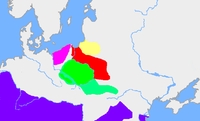
Debczyn culture
Encyclopedia

Pomerania
Pomerania is a historical region on the south shore of the Baltic Sea. Divided between Germany and Poland, it stretches roughly from the Recknitz River near Stralsund in the West, via the Oder River delta near Szczecin, to the mouth of the Vistula River near Gdańsk in the East...
from the 3rd to 6th centuries. It was derived from the East Germanic
East Germanic tribes
The Germanic tribes referred to as East Germanic constitute a wave of migrants who may have moved from Scandinavia into the area between the Oder and Vistula rivers between the years 600 and 300 BC. Later they went to the south...
Wielbark culture with influences from the Elbe region, and succeeded by migration of West Slavs
West Slavs
The West Slavs are Slavic peoples speaking West Slavic languages. They include Poles , Czechs, Slovaks, Lusatian Sorbs and the historical Polabians. The northern or Lechitic group includes, along with Polish, the extinct Polabian and Pomeranian languages...
, the Pomeranian tribes.
In the second half of the third century, the Dębczyn (Denzin) culture (or group) succeeded the Willenberg culture between the Persante and Drage
Drawa
Drawa is a river in north-western Poland, a tributary of the Notec river , with a length of 186 kilometres and the basin area of 3,296 km2.Towns:*Drawsko Pomorskie*Drawno*Krzyz Wielkopolski-See also:...
rivers, and a local, not yet classified culture between the lower Oder
Oder
The Oder is a river in Central Europe. It rises in the Czech Republic and flows through western Poland, later forming of the border between Poland and Germany, part of the Oder-Neisse line...
and Persante rivers. The adjacent areas to the east were uninhabited by this time. Whether the eastern Dębczyn culture replaced or evolved from the Willenberg culture is not yet known, in the western areas, settlement was continuous. The emergence of this group is characterized by an influence of the Vistula region (Willenberg culture), the expansion of the Gustow group
Gustow group
The Gustow group is an archaeological culture of the Roman Iron Age in Western Pomerania. The Gustow group is associated with the Germanic tribe of the Rugii....
, and many paralleles to the Elbe
Elbe
The Elbe is one of the major rivers of Central Europe. It rises in the Krkonoše Mountains of the northwestern Czech Republic before traversing much of Bohemia , then Germany and flowing into the North Sea at Cuxhaven, 110 km northwest of Hamburg...
Germanic areas. The dead were buried unburned. The culture existed until the first quarter of the 6th century, when burial of the dead in grave fiels stopped.
The Dębczyn group might comprise the archaeological remnants of Tacitus
Tacitus
Publius Cornelius Tacitus was a senator and a historian of the Roman Empire. The surviving portions of his two major works—the Annals and the Histories—examine the reigns of the Roman Emperors Tiberius, Claudius, Nero and those who reigned in the Year of the Four Emperors...
' Lemovii
Lemovii
The Lemovii were a Germanic tribe, only once named by Tacitus in the late 1st century. He noted that they lived near the Rugii and Goths and that they had short swords and round shields.The Oxhöft culture is associated with parts of the Rugii and Lemovii...
, probably identical with Widsith
Widsith
Widsith is an Old English poem of 144 lines that appears to date from the 9th century, drawing on earlier oral traditions of Anglo-Saxon tale singing. The only text of the fragment is copied in the Exeter Book, a manuscript of Old English poetry compiled in the late 10th century containing...
's Glommas, who are believed to have been the neighbors of the Rugians
Rugians
"Rugi" redirects here. For the Romanian villages by this name, see Păltiniş, Caraş-Severin and Turcineşti.The Rugii, also Rugians, Rygir, Ulmerugi, or Holmrygir were an East Germanic tribe migrated from southwest Norway to Pomerania around 100 AD, and from there to the Danube River valley...
, a tribe dwelling at the Pomerania
Pomerania
Pomerania is a historical region on the south shore of the Baltic Sea. Divided between Germany and Poland, it stretches roughly from the Recknitz River near Stralsund in the West, via the Oder River delta near Szczecin, to the mouth of the Vistula River near Gdańsk in the East...
n coast before the migration period
Migration Period
The Migration Period, also called the Barbarian Invasions , was a period of intensified human migration in Europe that occurred from c. 400 to 800 CE. This period marked the transition from Late Antiquity to the Early Middle Ages...
. Germanic saga
Saga
Sagas, are stories in Old Norse about ancient Scandinavian and Germanic history, etc.Saga may also refer to:Business*Saga DAB radio, a British radio station*Saga Airlines, a Turkish airline*Saga Falabella, a department store chain in Peru...
s report a battle on the isle of Hiddensee
Hiddensee
Hiddensee is a carfree island in the Baltic Sea, located west of Rügen on the German coast.The island, located 54°33' north longitude 13°07' east, has about 1,300 inhabitants. It was a popular vacation destination for East German tourists during German Democratic Republic times and continues to...
between king Hetel (Hethin, Heodin of the Glommas) and Rugian king Hagen, following the abdication of Hagen's daughter Hilde by Hetel. Yet, there are also other hypotheses about the location of the Lemovii, and that their identification as Glommas, though probable, is not certain.
See also
- Early history of PomeraniaEarly history of PomeraniaAfter the glaciers of the Ice Age in the Early Stone Age withdrew from Pomerania, in what are now northern Germany and Poland, they left a tundra. First humans appeared, hunting reindeer in the summer. A climate change in 8000 BC allowed hunters and foragers of the Ertebølle-Ellerbek culture to...
- GothsGothsThe Goths were an East Germanic tribe of Scandinavian origin whose two branches, the Visigoths and the Ostrogoths, played an important role in the fall of the Roman Empire and the emergence of Medieval Europe....
- Wielbark culture

